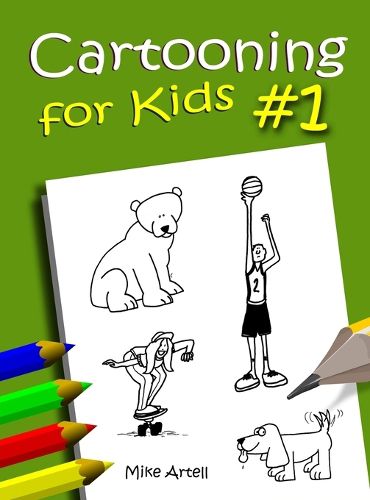Readings Newsletter
Become a Readings Member to make your shopping experience even easier.
Sign in or sign up for free!
You’re not far away from qualifying for FREE standard shipping within Australia
You’ve qualified for FREE standard shipping within Australia
The cart is loading…






This title is printed to order. This book may have been self-published. If so, we cannot guarantee the quality of the content. In the main most books will have gone through the editing process however some may not. We therefore suggest that you be aware of this before ordering this book. If in doubt check either the author or publisher’s details as we are unable to accept any returns unless they are faulty. Please contact us if you have any questions.
CARTOONING FOR KIDS #1 is the first in a series of how-to-draw-cartoons books for beginning cartoonists. Unlike many "how to draw" books, MIke puts less emphasis on "underlying structure" and more emphasis on "outlines and edges," which is the way most kids like to draw. Mike Artell has taught hundreds of thousands of kids (and adults!) how to draw cartoons using this, "outlines and edges" approach during his school visits, on television and online. Mike's goal is to help young cartoonists focus on the Three R's when drawing their cartoons:
The cartoons should be RECOGNIZABLE. In other words, the cartoons should look like what you're trying to draw. Someone should be able to look at a drawing you've done and know what it is you've drawn. It could be a dog, a whale, etc. It's not necessary that the cartoon is an, "accurate" drawing of a dog or whale, only that the viewer can easily recognize what it is you've drawn. In fact, sometimes "inaccuracies" are really funny. The cartoons should be REMARKABLE. The finished product should be something that elicits an honest, positive reaction from the viewer. A typical positive reaction from the viewer might be something like, "Wow! This is really good. I didn't know you could draw like this." The cartoons should be REPRODUCIBLE. If you learn how to draw a particular cartoon once, it should be possible to draw a similar cartoon again if you decide to do so in the future.
It doesn't matter if you draw with a pencil on a sheet a paper, a piece of chalk on the sidewalk, or an electronic drawing device. The first step is to make a mark on a blank surface. There aren't many rules for creating cartoons, so feel free to stretch your creative muscles and have some fun.
cartooning;drawing;art;cartoons;illustrations;graphics;doodles;
$9.00 standard shipping within Australia
FREE standard shipping within Australia for orders over $100.00
Express & International shipping calculated at checkout
This title is printed to order. This book may have been self-published. If so, we cannot guarantee the quality of the content. In the main most books will have gone through the editing process however some may not. We therefore suggest that you be aware of this before ordering this book. If in doubt check either the author or publisher’s details as we are unable to accept any returns unless they are faulty. Please contact us if you have any questions.
CARTOONING FOR KIDS #1 is the first in a series of how-to-draw-cartoons books for beginning cartoonists. Unlike many "how to draw" books, MIke puts less emphasis on "underlying structure" and more emphasis on "outlines and edges," which is the way most kids like to draw. Mike Artell has taught hundreds of thousands of kids (and adults!) how to draw cartoons using this, "outlines and edges" approach during his school visits, on television and online. Mike's goal is to help young cartoonists focus on the Three R's when drawing their cartoons:
The cartoons should be RECOGNIZABLE. In other words, the cartoons should look like what you're trying to draw. Someone should be able to look at a drawing you've done and know what it is you've drawn. It could be a dog, a whale, etc. It's not necessary that the cartoon is an, "accurate" drawing of a dog or whale, only that the viewer can easily recognize what it is you've drawn. In fact, sometimes "inaccuracies" are really funny. The cartoons should be REMARKABLE. The finished product should be something that elicits an honest, positive reaction from the viewer. A typical positive reaction from the viewer might be something like, "Wow! This is really good. I didn't know you could draw like this." The cartoons should be REPRODUCIBLE. If you learn how to draw a particular cartoon once, it should be possible to draw a similar cartoon again if you decide to do so in the future.
It doesn't matter if you draw with a pencil on a sheet a paper, a piece of chalk on the sidewalk, or an electronic drawing device. The first step is to make a mark on a blank surface. There aren't many rules for creating cartoons, so feel free to stretch your creative muscles and have some fun.
cartooning;drawing;art;cartoons;illustrations;graphics;doodles;